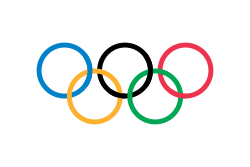Wilfred Bungei
| Wilfred Bungei | |
|---|---|
 | |
| Narození | 24. července 1980 (42 let) Kabirirsang |
| Povolání | běžec na středně dlouhé tratě |
| Některá data mohou pocházet z datové položky. | |
| Přehled medailí | ||
|---|---|---|
| zlato | Peking 2008 | běh na 800 m |
| Mistrovství světa v atletice | ||
| stříbro | Edmonton 2001 | 800 m |
| Halové MS v atletice | ||
| bronz | Birmingham 2003 | 800 m |
| zlato | Moskva 2006 | 800 m |
| Mistrovství světa juniorů v atletice | ||
| stříbro | Annecy 1998 | 800 m |
Wilfred Kipkemboi Bungei (* 24. červenec 1980, Kabirirsang) je keňský běžec na střední tratě.
Kariéra
Úspěchy začal sbírat rokem 1998, kdy byl na juniorském mistrovství světa v atletice stříbrný v běhu na 800 metrů. V roce 2002 a 2003 byl nejlepším běžcem na 800 metrů.
V roce 2001 získal stříbrnou medaili v běhu na 800 metrů na Mistrovství světa v atletice, v roce 2006 stejný šampionát (tentokrát halový) vyhrál, opět na 800 m.
Bungei reprezentoval Keňu na olympiádě v Aténách 2004 a na olympiádě v Pekingu 2008 získal zlatou medaili.[1]
Od roku 2006 je Bungei také světovým rekordmanem na méně vypisované štafetové trati 4×800 metrů.
Osobní rekordy
Dráha
- Běh na 800 metrů – 1:42,34 – 8. září 2002, Rieti
Hala
- Běh na 800 metrů – 1:44,97 – 2. února 2003, Stuttgart
Osobní život
Bungei je ženatý a má dva syny.
Odkazy
Reference
- ↑ Wilfred Bungei - Kenya - 2008 Olympic 800m Champion (result) [online]. Sporting-Heroes.net. Dostupné online. (anglicky)
Externí odkazy
 Obrázky, zvuky či videa k tématu Wilfred Bungei na Wikimedia Commons
Obrázky, zvuky či videa k tématu Wilfred Bungei na Wikimedia Commons - Wilfred Bungei na stránkách Světové atletiky (anglicky)
- Wilfred Bungei v databázi Olympedia (anglicky)
Média použitá na této stránce
Olympic Rings without "rims" (gaps between the rings), As used, eg. in the logos of the 2008 and 2016 Olympics. The colour scheme applied here was specified in 2023 guidelines.
Olympic Rings without "rims" (gaps between the rings), As used, eg. in the logos of the 2008 and 2016 Olympics. The colour scheme applied here was specified in 2023 guidelines.
US Flag with 45 stars. In use 4 July 1896–3 July 1908. Created by jacobolus using Adobe Illustrator, and released into the public domain. This flag was used during the Spanish-American War.
US Flag with 45 stars. In use 4 July 1896–3 July 1908. Created by jacobolus using Adobe Illustrator, and released into the public domain. This flag was used during the Spanish-American War.
US Flag with 46 stars. In use 4 July 1908–3 July 1912. Created by jacobolus using Adobe Illustrator, and released into the public domain.
Other version: Image:US 46 Star Flag.svgUS Flag with 48 stars. In use for 47 years from July 4, 1912, to July 3, 1959.
Olympijská vlajka
The flag of Brazil from 1968 to 1992 with 23 stars.
Flag of Jamaica. “The sunshine, the land is green, and the people are strong and bold” is the symbolism of the colours of the flag. GOLD represents the natural wealth and beauty of sunlight; GREEN represents hope and agricultural resources; BLACK represents the strength and creativity of the people. The original symbolism, however, was "Hardships there are, but the land is green, and the sun shineth", where BLACK represented the hardships being faced.
Used color: National flag | South African Government and Pantone Color Picker
| zelená | rendered as RGB 0 119 73 | Pantone 3415 C |
| žlutá | rendered as RGB 255 184 28 | Pantone 1235 C |
| červená | rendered as RGB 224 60 49 | Pantone 179 C |
| modrá | rendered as RGB 0 20 137 | Pantone Reflex Blue C |
| bílá | rendered as RGB 255 255 255 | |
| černá | rendered as RGB 0 0 0 |
Vlajka Etiopie
US Flag with 46 stars. In use 4 July 1908–3 July 1912. Created by jacobolus using Adobe Illustrator, and released into the public domain.
Other version: Image:US 46 Star Flag.svgAutor:
- Osaka07_D7A_Wilfried_Bungei.jpg: unknown
- derivative work: MachoCarioca (talk)
World Athletics Championships 2007 in Osaka - 800 metres runner Wilfried Bungei after the semifinal
The flag of Brazil from 1968 to 1992 with 23 stars.























